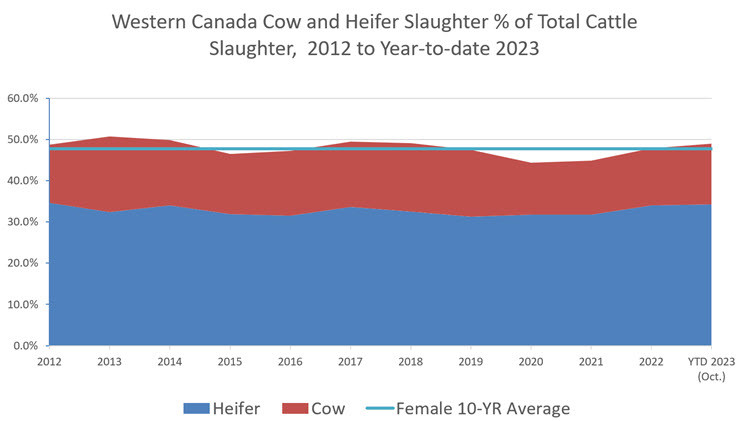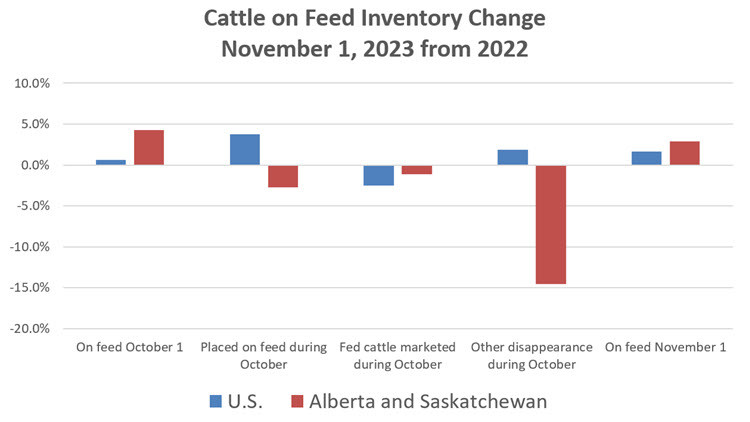Non-urgent government operations are closed December 24 to January 1, reopening January 2. View available services during this period.
See event listings and more articles in this edition of Agri-News: November 27, 2023 issue
“The proportion of female (heifer and cow) cattle slaughter relative to total cattle slaughter has increased,” says Ann Boyda, provincial livestock market analyst with the Alberta government. “A greater share of females going to slaughter makes it more difficult to rebuild the herd.”
Over the last decade, Western Canada female slaughter represented 47.7% of the total cattle slaughtered. The 10-year average share of heifer to total cattle slaughter was 32.7%. Year-to-date (January to end of October 2023) female cattle slaughter estimates are at 49%, with heifers representing 34.3% of the total cattle slaughter. The increase in share of female slaughter has increased from the 2020 low of 44.4%.
Figure 1. Western Canada Cow and Heifer Slaughter

“Even with record high cattle prices and the strong demand for beef, producers have not responded with herd expansion,” says Boyda. “Producer restraint is attributed to concerns of rising input costs and risk of another year of dry conditions. Forecasts by Art Douglas, weather forecaster from Creighton University in the U.S., call for a short and sharp El Nino that could end in May 2024. The peak of its intensity will be the January to March period of 2024.”
Multi-year droughts impacts are cumulative and can result in land degradation, more wildfires, heatwaves, water scarcity, vegetation loss and reduction in livestock and crop productivity. Persistent drought also makes it difficult to stabilize the cattle herd.
“A closer look at the heifer placement decisions on cattle feeding operations over the last 3 years reveals a seasonal pattern but also a year-over-year increase. The greatest share of monthly heifer placement relative to total feeder placements was in June 2023 at 53.5% followed by September 2023 at 47%. Signs point to a return to seasonal share toward the end of 2023.”
The USDA November Cattle on Feed report showed inventory estimates of 11.931 million head on feed, 2% higher than November 2022 but within expectations. The report estimates October placements at 3.8% larger than a year ago, while fed cattle marketed in October were 2.5% lower than last year. USDA reported increases in placements over the last 3 months. The lower marketings may lower feedlot margins, however, Boyda points out 2023 is expected to see overall good margin returns.
Canfax’s Cattle on Feed report for November 1 cattle numbers in Alberta and Saskatchewan estimate 1.099 million head, up 3% from 2022. Placements in October 2023 were down 3% from last year. Fed cattle marketings during October were down 1% from 2022.
Figure 2. Cattle on Feed Inventory Change

“With rain comes hope,” says Boyda. “Should prices continue to support the prospect of recovery, and moisture arrive at the right time in spring 2024, there can be hope for the cattle herd to begin its rebuild.”
For more information, see:
Contact
Connect with Ann Boyda for more information:
Phone: 780-422-4088
Email: [email protected]
Sign up for Agri-News
Start every Monday with the week’s top agricultural stories and latest updates.
Read about all things agriculture at Alberta.ca/agri-news